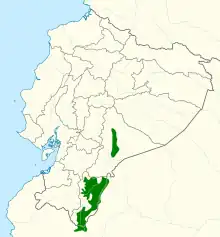White-breasted parakeet
The white-breasted parakeet (Pyrrhura albipectus) or white-necked parakeet is a Vulnerable species of bird in subfamily Arinae of the family Psittacidae, the African and New World parrots.[3][1] It is found in southern Ecuador and possibly in adjacent northern Peru.[4]
| White-breasted Parakeet | |
|---|---|
.jpg.webp) | |
| Scientific classification | |
| Domain: | Eukaryota |
| Kingdom: | Animalia |
| Phylum: | Chordata |
| Clade: | Dinosauria |
| Class: | Aves |
| Order: | Psittaciformes |
| Family: | Psittacidae |
| Genus: | Pyrrhura |
| Species: | P. albipectus |
| Binomial name | |
| Pyrrhura albipectus Chapman, 1914 | |
 | |
Description
The white-breasted parakeet is 24 to 25.5 cm (9.4 to 10 in) long and weighs 83 to 110 g (2.9 to 3.9 oz). The sexes are the same. Adults have a thin reddish brown band just above the bill and are brownish from forehead to hindcrown; the crown feathers have gray edges. Their cheeks are green with yellow giving a scaly appearance and their ear coverts are orange. A wide white collar surrounds their neck and the rest of their upperparts are green. Their breast is yellow and the rest of their underparts are green with a rusty tone on the belly. Their wing is mostly green with red primary coverts and dark bluish primaries. The upper side of their tail is dull reddish with a green base and the underside dusky with reddish tips to the feathers. Their bill is blackish and their iris is dark with bare white or whitish skin surrounding it. Immature birds are similar to adults but without the reddish frontal band; they also have paler ear coverts and a white breast.[5][6]
Distribution and habitat
The white-breasted parakeet is found on the eastern slope of the Andes in the southeastern Ecuadoran provinces of Morona-Santiago and Zamora-Chinchipe, and possibly in northernmost Cajamarca in Peru. The South American Classification Committee of the American Ornithological Society considers it to be endemic to Ecuador; undocumented sight records in Peru lead the committee to treat it as hypothetical in that country.[3][7][4] It inhabits the canopy, clearings, and edges of primary subtropical and tropical forest at elevations between 900 and 2,000 m (3,000 and 6,600 ft) though it usually is found below 1,700 m (5,600 ft).[5][6]
Behavior
Movement
The white-breasted parakeet is not known to have any pattern of movements.[5]
Feeding
The white-breasted parakeet feeds on fruit, seeds, and flowers of a variety of plants and trees.[5]
Breeding
The white-breasted parakeet nests between May and July, but nothing else is known about its breeding biology.[5]
Vocalization
The white-breasted parakeet's most common call is "a series of harsh notes, e.g. “krree krree krree” " that is given both from a perch and in flight. Perched birds also call with single "kurree" or "rrah" notes, though perched birds are often silent. Flocks in flight "call frequently and simultaneously, producing a noisy, harsh chattering."[5]
Status
The IUCN originally assessed the white-breasted parakeet as Threatened but since 1994 has treated it as Vulnerable. It has a small range and its estimated population of under 10,000 mature individuals is believed to be decreasing. "Habitat destruction is the principal concern, as upper tropical zone forests east of the Andes are being cleared at an alarming rate." It occurs in Podocarpus National Park and the Tapichalaca Reserve, though the former has lost some habitat due to illegal encroachment.[1] In Tapichalaca Reserve the Fundación Jocotoco has erected nest boxes for the parakeet.[8][9]
References
- BirdLife International (2021). "White-necked Parakeet Pyrrhura albipectus". IUCN Red List of Threatened Species. 2016: e.T22685860A195447344. doi:10.2305/IUCN.UK.2021-3.RLTS.T22685860A195447344.en. Retrieved 13 March 2023.
- "Appendices | CITES". cites.org. Retrieved 4 March 2023.
- Gill, F.; Donsker, D.; Rasmussen, P., eds. (January 2023). "Parrots, cockatoos". IOC World Bird List. v 13.1. Retrieved 18 February 2023.
- Remsen, J. V., Jr., J. I. Areta, E. Bonaccorso, S. Claramunt, A. Jaramillo, D. F. Lane, J. F. Pacheco, M. B. Robbins, F. G. Stiles, and K. J. Zimmer. 30 January 2023. Species Lists of Birds for South American Countries and Territories. https://www.museum.lsu.edu/~Remsen/SACCCountryLists.htm retrieved January 30, 2023
- Collar, N. and P. F. D. Boesman (2020). White-necked Parakeet (Pyrrhura albipectus), version 1.0. In Birds of the World (J. del Hoyo, A. Elliott, J. Sargatal, D. A. Christie, and E. de Juana, Editors). Cornell Lab of Ornithology, Ithaca, NY, USA. https://doi.org/10.2173/bow.whnpar1.01 retrieved March 13, 2023
- Ridgely, Robert S.; Greenfield, Paul J. (2001). The Birds of Ecuador: Field Guide. Vol. II. Ithaca: Cornell University Press. p. 190. ISBN 978-0-8014-8721-7.
- Navarrete, L. (2003). Neotropical Notebook: White-breasted parakeet Pyrrhura albipectus: a new record for Peru. Cotinga. 19: 79
- "Tapichalaca Reserve". American Bird Conservancy. Retrieved March 13, 2023.
- Waugh, D. (2009). A tiriba-do-pescoço-branco (Pyrrhura albipectus) no Equador meridional: notícias sobre a sua conservação.[The White-necked Parakeet (Pyrrhura albipectus) in southern Ecuador: news on its conservation] Atualidades Ornitológicas. 147: 50–51. In Portuguese.
